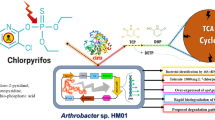Abstract
Triazophos is one of the most widely used organophosphorus insecticides usually detectable in the environment. A bacterial strain, Diaphorobacter sp. TPD-1, capable of using triazophos and its intermediate, 1-phenyl-3-hydroxy-1,2,4-triazole (PHT), as its sole carbon sources for growth was isolated from a triazophos-contaminated soil in China. This strain could completely degrade 50 mg l−1 triazophos and PHT to non-detectable level in 24 and 56 h, respectively. During PHT degradation, three metabolites were detected and identified based on tandem mass spectrometry (MS/MS) analysis. Using this information, a biochemical degradation pathway of triazophos by Diaphorobacter sp. TPD-1 was proposed. The first step involved in the degradation of triazophos is the hydrolysis of the P–O ester bond of triazophos to form PHT and o,o-diethyl phosphorothioic acid, then the triazol ring of PHT is subsequently cleaved to form (E)-1-formyl-2-phenyldiazene. Subsequently, (E)-1-formyl-2-phenyldiazene is transformed to 2-phenylhydrazinecarboxylic acid by adding one molecular of H2O. Finally, the carboxyl group of 2-phenylhydrazinecarboxylic acid is decarboxylated to form phenylhydrazine.






Similar content being viewed by others
References
Alexis JH, Li C, Ian CS (2001) Thermal stability of organophosphorus pesticide triazophos and its relevance in the assessment of risk to the consumer of triazophos residues in food. J Agric Food Chem 49:103–106
Andersona BS, Hunta JW (2003) Integrated assessment of the impacts of agricultural drain water in the Salinas River (California, USA). Environ Pollut 124:523–532
Aungpradit T, Sutthivaiyakit P, Martens D et al (2007) Photocatalytic degradation of triazophos in aqueous titanium dioxide suspension: identification of intermediates and degradation pathways. J Hazard Mater 146:204–213
Cai TM, Qian LH, Cai S et al. (2010) Biodegradation of Benazolin-ethyl by strain Methyloversatilis sp. cd-1 isolated from activated sludge. Curr Microbiol. doi:10.1007/s00284-010-9746-7
Cheng S, Xiao J, Xiao H et al (2007) Technical note phytoremediation of triazophos by Canna indica Linn. in a hydroponic system. Int J Phytoremediation 9:453–463
Dai QH, Zhang RF, Jiang JD et al (2007) Cloning of triazophos hydrolase gene and the determination of the hydrolysate. China Environ Sci 27:777–780
Guo XQ, Li R, Lin D et al (2009) Isolation and characterization of a triazophos-degrading strain GS-1 and its degrading characteristics. Microbiology (China) 36:1143–1149
Holt JG, Krieg NR, Sneath PHA et al (1994) Bergey’s manual of determinative bacteriology, 9th edn. The Williams and Wilkins Company, Baltimore
Li XH, He J, Li SP (2007) Isolation of a chlorpyrifos-degrading bacterium, Sphingomonas sp strain Dsp-2, and cloning of the mpd gene. Res Microbiol 158:143–149
Li W, Qiu SP, Wu YJ (2008) Triazophos residues and dissipation rates in wheat crops and soil. Ecotoxicol Environ Saf 69:312–316
Li RX, Yang CP, Chen H et al (2009) Removal of triazophos pesticide from wastewater with Fenton reagent. J Hazard Mater 67:1028–1032
Lin KD, Yuan DX (2005) Degradation kinetics and products of triazophos in intertidal sediment. J Environ Sci (China) 17:933–936
Lin KD, Yuan DX, Chen M et al (2004) Kinetics and products of photo-Fenton degradation of triazophos. J Agric Food Chem 52:7614–7620
Lin KD, Yuan DX, Deng YZ et al (2004) Hydrolytic products and kinetics of triazophos in buffered and alkaline solutions with different values of pH. J Agric Food Chem 52:5404–5411
Rovedatti MG (2001) Monitoring of organochlorine and organophosphorus pesticides in the water of the Reconquista River. Water Res 35:3457–3461
Sawaya WN, Fawzia A, Awadhi A (2000) Dietary intake of organophosphate pesticides in Kuwait (analytical, nutritional and clinical methods section). Food Chem 69:331–338
Singh BK, Walker A (2006) Microbial degradation of organophosphorus compounds. FEMS Microbiol Rev 30:428–471
Velazquez A, Xamena N, Creus A, Marcos R (1990) Mutagenic evaluation of the organophosphorus insecticides methyl parathion and triazophos in Drosophila melanogaster. J Toxicol Environ Health 31:313–325
Wang LH, Zhang L, Chen HL et al (2005) Isolation of a triazophos-degrading strain Klebsiella sp E6 effectively utilizing triazophos as sole nitrogen source. FEMS Microbiol Lett 253:259–265
Wang XD, Liu XJ, Yang S et al (2007) Removal and toxicological response of triazophos by Chlamydomonas reinhardtii. Bull Environ Contam Toxicol 78:67–71
Wilson KH, Blitchington RB, Greene RC (1990) Amplification of bacterial-16s ribosomal DNA with polymerase chain-reaction. J Clin Microbiol 28:1942–1946
Xiao HP, Cheng SP, Wu ZB (2010) Microbial community variation in phytoremediation of triazophos by Canna indica Linn. in a hydroponic system. J Environ Sci (China) 8:1225–1231
Acknowledgments
This work was supported by grants from the Major Projects on Control and Rectification of Water Body Pollution (2009ZX07103-002), the Chinese National Natural Science Foundation (31070100), and the Key Technology R&D Program of Jiangsu Province (BE2008669).
Author information
Authors and Affiliations
Corresponding author
Additional information
Chenli Yang and Rong Li contributed equally to this article.
Rights and permissions
About this article
Cite this article
Yang, C., Li, R., Song, Y. et al. Identification of the Biochemical Degradation Pathway of Triazophos and its Intermediate in Diaphorobacter sp. TPD-1. Curr Microbiol 62, 1294–1301 (2011). https://doi.org/10.1007/s00284-010-9859-z
Received:
Accepted:
Published:
Issue Date:
DOI: https://doi.org/10.1007/s00284-010-9859-z




